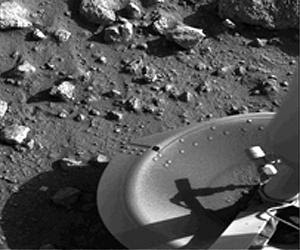NASA has repeatedly stated that its new mission to Mars, Curiosity, carries no life detector.
Yet, Gilbert V. Levin, Experimenter on NASA's 1976 Viking Mission, disagrees.
He says instruments aboard Curiosity can confirm his published claim that his Labeled Release (LR) experiment detected living microorganisms on Mars.
Dr. Levin was Experimenter and Dr. Patricia Ann Straat Co-Experimenter on the experiment that produced evidence of life on Mars.
Because another Viking instrument failed to find organic matter, the stuff of life, NASA discounted the LR results. Since Viking, Mars missions have sought only evidence of habitability, not life itself.
Levin now claims the organic analyzers and the high-resolution camera on Curiosity as his "stealth life detectors."
After twenty years of analyzing the LR data, reviewing flaws in Viking's organic detector, and studying new information on life obtained from Mars and Earth, Levin finally announced his "life claim" in a 1997 publication.
today, he said that, should Curiosity detect organic matter, the last obstacle to his claim to life on Mars will vanish. Co-Experimenter Straat agrees with Levin, saying, "I look forward to Curiosity data that may confirm our life interpretation of the LR."
Levin's other "virtual experiment" is Curiosity's high-resolution camera. It might determine whether "lichen-like" colored patches Levin found on rocks at the Viking sites might be living organisms.
Patricia Straat, and JPL's William Benton assisted him in the study which subjected images of the Mars rocks and terrestrial rocks bearing lichen to the Viking Imaging System.
Visible and infrared spectral analyses found the same responses from the Mars and terrestrial images (Levin, G. V., P. A. Straat and W. D. Benton, "Color and Feature Changes at Mars Viking Lander Site," J. Theoret. Biol., 75, 381-390, 1978 - available at gillevin.com, tab "Mars Research").
Levin has now written Dr. Mike Malin, designer of Curiosity's camera, asking him to seek and take high-resolution pictures of any such patches, hoping to determine whether Viking found living organisms on the rocks.
Levin (see biog. gillevin.com) started his Mars life-seeking efforts in 1958. Funded by NASA, he began developing the LR. In 1969, NASA appointed Levin as Team Member of the IRIS experiment aboard the 1971 Mariner 9 Mars orbiter. Dr. Straat joined that effort in 1970. They sought organic gases in the Martian atmosphere.
None were found, but recent observers of Mars have claimed detecting methane, possibly of microbial origin. Following Viking, Levin was appointed Team Member of NASA's MOx experiment aboard the Russian '96 Mission to Mars, converting that soil analysis instrument to give it life detection capability. However, the spacecraft crashed after launch.
"This is a very exciting time," says Levin, now an adjunct professor at Arizona State University, Tempe, "something for which I have been waiting for years. At the very least, the Curiosity results may bring about my long-requested re-evaluation of the Viking LR results."
Yet, Gilbert V. Levin, Experimenter on NASA's 1976 Viking Mission, disagrees.
He says instruments aboard Curiosity can confirm his published claim that his Labeled Release (LR) experiment detected living microorganisms on Mars.
Dr. Levin was Experimenter and Dr. Patricia Ann Straat Co-Experimenter on the experiment that produced evidence of life on Mars.
Because another Viking instrument failed to find organic matter, the stuff of life, NASA discounted the LR results. Since Viking, Mars missions have sought only evidence of habitability, not life itself.
Levin now claims the organic analyzers and the high-resolution camera on Curiosity as his "stealth life detectors."
After twenty years of analyzing the LR data, reviewing flaws in Viking's organic detector, and studying new information on life obtained from Mars and Earth, Levin finally announced his "life claim" in a 1997 publication.
today, he said that, should Curiosity detect organic matter, the last obstacle to his claim to life on Mars will vanish. Co-Experimenter Straat agrees with Levin, saying, "I look forward to Curiosity data that may confirm our life interpretation of the LR."
Levin's other "virtual experiment" is Curiosity's high-resolution camera. It might determine whether "lichen-like" colored patches Levin found on rocks at the Viking sites might be living organisms.
Patricia Straat, and JPL's William Benton assisted him in the study which subjected images of the Mars rocks and terrestrial rocks bearing lichen to the Viking Imaging System.
Visible and infrared spectral analyses found the same responses from the Mars and terrestrial images (Levin, G. V., P. A. Straat and W. D. Benton, "Color and Feature Changes at Mars Viking Lander Site," J. Theoret. Biol., 75, 381-390, 1978 - available at gillevin.com, tab "Mars Research").
Levin has now written Dr. Mike Malin, designer of Curiosity's camera, asking him to seek and take high-resolution pictures of any such patches, hoping to determine whether Viking found living organisms on the rocks.
Levin (see biog. gillevin.com) started his Mars life-seeking efforts in 1958. Funded by NASA, he began developing the LR. In 1969, NASA appointed Levin as Team Member of the IRIS experiment aboard the 1971 Mariner 9 Mars orbiter. Dr. Straat joined that effort in 1970. They sought organic gases in the Martian atmosphere.
None were found, but recent observers of Mars have claimed detecting methane, possibly of microbial origin. Following Viking, Levin was appointed Team Member of NASA's MOx experiment aboard the Russian '96 Mission to Mars, converting that soil analysis instrument to give it life detection capability. However, the spacecraft crashed after launch.
"This is a very exciting time," says Levin, now an adjunct professor at Arizona State University, Tempe, "something for which I have been waiting for years. At the very least, the Curiosity results may bring about my long-requested re-evaluation of the Viking LR results."







No comments:
Post a Comment